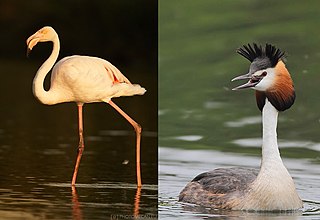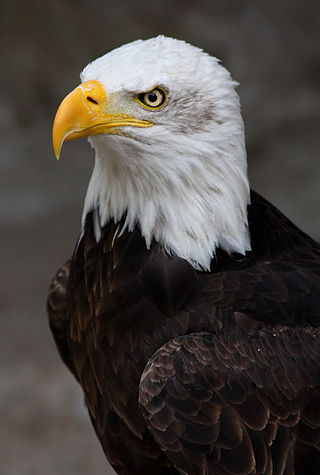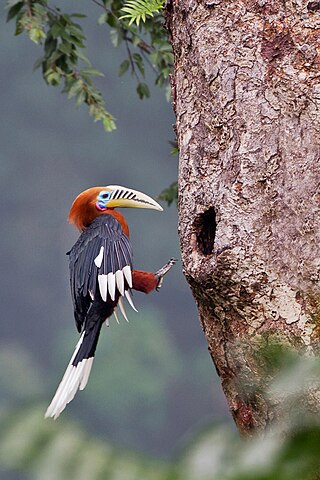
The mesites (Mesitornithidae) are a family of birds that are part of a clade (Columbimorphae) that include Columbiformes and Pterocliformes. They are smallish flightless or near flightless birds endemic to Madagascar. They are the only family with more than two species in which every species is threatened.

Palaeognathae is an infraclass of birds, called paleognaths or palaeognaths, within the class Aves of the clade Archosauria. It is one of the two extant infraclasses of birds, the other being Neognathae, both of which form Neornithes. Palaeognathae contains five extant branches of flightless lineages, termed ratites, and one flying lineage, the Neotropic tinamous. There are 47 species of tinamous, five of kiwis (Apteryx), three of cassowaries (Casuarius), one of emus (Dromaius), two of rheas (Rhea) and two of ostriches (Struthio). Recent research has indicated that paleognaths are monophyletic but the traditional taxonomic split between flightless and flighted forms is incorrect; tinamous are within the ratite radiation, meaning flightlessness arose independently multiple times via parallel evolution.

Neoaves is a clade that consists of all modern birds with the exception of Palaeognathae and Galloanserae. This group is defined in the PhyloCode by George Sangster and colleagues in 2022 as "the most inclusive crown clade containing Passer domesticus, but not Gallus gallus". Almost 95% of the roughly 10,000 known species of extant birds belong to the Neoaves.

Mirandornithes is a clade that consists of flamingos and grebes. Many scholars use the term Phoenicopterimorphae for the superorder containing flamingoes and grebes.

Aequornithes, or core water birds, are defined as "the least inclusive crown clade containing Pelecanus onocrotalus and Gavia immer".

Afroaves is a clade of birds, consisting of the kingfishers and kin (Coraciiformes), woodpeckers and kin (Piciformes), hornbills and kin (Bucerotiformes), trogons (Trogoniformes), cuckoo roller (Leptosomiformes), mousebirds (Coliiformes), owls (Strigiformes), raptors (Accipitriformes) and New World vultures (Cathartiformes). The most basal clades are predatory, suggesting the last common ancestor of Afroaves was also a predatory bird. This group was defined in the PhyloCode by George Sangster and colleagues in 2022 as "the least inclusive crown clade containing Accipiter nisus, Colius colius, and Picus viridis, but not Passer domesticus".

Telluraves is a recently defined clade of birds defined by their arboreality. Based on most recent genetic studies, the clade unites a variety of bird groups, including the australavians as well as the afroavians. This grouping was defined in the PhyloCode by George Sangster and colleagues in 2022 as "the least inclusive crown clade containing Accipiter nisus and Passer domesticus". They appear to be the sister group of the Phaethoquornithes.

Passerea is a clade of neoavian birds that was proposed by Jarvis et al. (2014). Their genomic analysis recovered two major clades within Neoaves, Passerea and Columbea, and concluded that both clades appear to have many ecologically driven convergent traits.

Eurypygimorphae or Phaethontimorphae is a clade of birds that contains the orders Phaethontiformes (tropicbirds) and Eurypygiformes recovered by genome analysis. The relationship was first identified in 2013 based on their nuclear genes. This group was defined in the PhyloCode by George Sangster and colleagues in 2022 as "the least inclusive crown clade containing Phaethon aethereus, Eurypyga helias, and Rhynochetos jubatus". Historically these birds were placed at different parts of the tree, with tropicbirds in Pelecaniformes and the kagu and sunbittern in Gruiformes. Some genetic analyses have placed the eurypygimorph taxa in the controversial and obsolete clade Metaves, with uncertain placement within that group. More recent molecular studies support their grouping together in Eurypygimorphae, which is usually recovered as the sister taxon to Aequornithes within Ardeae.

Austrodyptornithes is a clade of birds that include the orders Sphenisciformes (penguins) and Procellariiformes. A 2014 analysis of whole genomes of 48 representative bird species concluded that penguins are the sister group of Procellariiformes, from which they diverged about 60 million years ago.

Coraciimorphae is a clade of birds that contains the order Coliiformes (mousebirds) and the clade Cavitaves. The name however was coined in the 1990s by Sibley and Ahlquist based on their DNA-DNA hybridization studies conducted in the late 1970s and throughout the 1980s. However their Coraciimorphae only contains Trogoniformes and Coraciiformes. Coraciimorphae was defined in the PhyloCode by George Sangster and colleagues in 2022 as "the least inclusive crown clade containing Colius colius and Picus viridis, but not Accipiter nisus or Passer domesticus".

Accipitrimorphae is a clade of birds of prey that include the orders Cathartiformes and Accipitriformes. However, this group might be a junior synonym of Accipitriformes. The DNA-based proposal and the NACC and IOC classifications include the New World vultures in the Accipitriformes, but the SACC classifies the New World vultures as a separate order, the Cathartiformes which has been adopted here. The placement of the New World vultures has been unclear since the early 1990s. The reason for this is the controversial systematic history of the New World vultures as they were assumed to be more related to Ciconiidae after Sibley and Ahlquist work on their DNA-DNA hybridization studies conducted in the late 1970s and throughout the 1980s. The stork-vulture relationship has seemed to not be supported. Regardless of whether to use Accipitrimorphae or Accipitriformes, these birds belong to the clade Telluraves.

Cavitaves is a clade that contains the order Leptosomiformes and the clade Eucavitaves. This group was defined in the PhyloCode by George Sangster and colleagues in 2022 as "the least inclusive crown clade containing Leptosomus discolor and Picus viridis". The name refers to the fact that the majority of them nest in cavities.

Picocoraciae is a clade that contains the order Bucerotiformes and the clade Picodynastornithes supported by various genetic analysis and morphological studies. While these studies supported a sister grouping of Coraciiformes and Piciformes, a large scale, sparse supermatrix has suggested alternative sister relationship between Bucerotiformes and Piciformes instead. This group was defined in the PhyloCode by George Sangster and colleagues in 2022 as "the least inclusive crown clade containing Buceros rhinoceros, Coracias garrulus, and Picus viridis".

Columbimorphae is a clade discovered by genome analysis that includes birds of the orders Columbiformes, Pterocliformes (sandgrouse), and Mesitornithiformes (mesites). This group was defined in the PhyloCode by George Sangster and colleagues in 2022 as "the least inclusive crown clade containing Columba oenas, Mesitornis variegatus, and Pterocles alchata". Previous analyses had also recovered this grouping, although the exact relationships differed. Some studies indicated a sister relationship between sandgrouse and pigeons while other studies favored a sister grouping of mesites and sandgrouse instead. This sister relationship of the sandgrouses and mesites was named by George Sangster and colleagues in 2022 as the clade Pteroclimesites and defined in the PhyloCode as "the least inclusive crown clade containing Mesitornis variegatus and Pterocles alchata".

Picodynastornithes is a clade that contains the orders Coraciiformes and Piciformes. This grouping also has current and historical support from molecular and morphological studies. This group was defined in the PhyloCode by George Sangster and colleagues in 2022 as "the least inclusive crown clade containing Coracias garrulus, Alcedo atthis, and Picus viridis".

Notopalaeognathae is a clade that contains the order Rheiformes (rheas), the clade Novaeratitae, and the clade Dinocrypturi. The exact relationships of this group, including its recently extinct members, have only recently been uncovered. The two lineages endemic to New Zealand, the kiwis and the extinct moas, are not each other's closest relatives: the moas are most closely related to the Neotropical tinamous, and the kiwis are sister to the extinct elephant birds of Madagascar, with kiwis and elephant birds together sister to the cassowaries and emu of New Guinea and Australia. The South American rheas are either sister to all other notopalaeognaths or sister to Novaeratitae. The sister group to Notopalaeognathae is Struthionidae.

Novaeratitae is a proposed clade that was originally defined to contain the recent common ancestors of the orders Casuariiformes and Apterygiformes (kiwis). Recently it has been determined that the elephant birds of the extinct order Aepyornithiformes were the closest relatives of the kiwis, and therefore are part of this group. The implication is that ratites had lost flight independently in each group, as the elephant birds are the only novaeratites found outside Oceania. This clade has been contested by other studies, which find the relationships between the four main clades of non-ostrich palaeognaths to be an unresolved polytomy, with only slightly more genetic support for Novaeritiae over alternative proposals.

Ardei is a suborder of order Pelecaniformes that include the families Ardeidae and Threskiornithidae. Traditionally the ardeids and threskiornithids were classified in the order Ciconiiformes along with Ciconiidae (storks), Phoenicopteridae (flamingos), Scopidae (hamerkop), Balaenicipitidae (shoebill), and even Cathartidae. However, there were some osteological studies that have questioned the monophyly of Ciconiiformes, suggesting that the ardeids and threskiornithids originated from early gruiforms, with the latter being a transitionary taxon to order Charadriiformes. The non-monophyletic nature of Ciconiiformes is supported by recent genomic studies that have found support for threskiornithids, ardeids, scopids and balaenicipitids being closely related to Pelecanidae (pelicans).



















